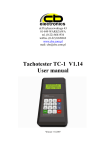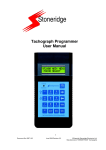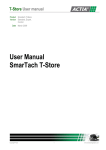Download User`s Manual (PDF 467K) - General Technologies Corp.
Transcript
General Technologies Corp. 1. SAFETY RULES • This instrument is designed for indoor use at temperatures between 32°F to 122°F (0°C to 50°C), altitudes up to 6500 ft. (2,000 m), and 10% to 90% relative humidity. • To ensure that the instrument is used safely, follow all safety and operating instructions in this manual. If the instrument is not used as described in this operation manual, the safety features of this device may be impaired. • To avoid personal injuries and damage to the instrument, use extreme caution when working around hot machine or engine parts, such as radiators, exhaust manifolds, catalytic converters, etc. 2. INTERNATIONAL SYMBOLS ! TA303 Diesel & Gasoline Engine Tachometer 4. OPERATION 4.1 Instrument Description 1 1) BNC jack connector 2) Protective rubber holster 2 3 3 3) LCD display SmarTach 3 4) Cylinder increase button 5) AUX button Diesel & Gasoline Engine Tachometer 6) Cylinder decrease button 7) Calibrate button 5 7 Cylinder AUX Calibrate Engine Cycles 2-4 Cylinder Instructions: 1- Connect terminals to engine’s alternator (battery, cigarette lighter, etc.) 2- Turn off all electrical accessories and turn on the headlights 3- Select number of cylinders and cycles for the engine 4- Press the ‘Calibrate’ button 8) Engine Cycles button General Technologies Corp. Made in Canada Important information Refer to the User’s Manual 3. TECHNICAL SPECIFICATIONS 3.1 General Specifications Display: LCD 4½ digit main measurement, number of cycles, number of cylinders, and units. Update rate: 3 updates per second Ignition system comp.: All Engine cycles: 2 and 4 cycles Number of cylinders: 1,2,3,4,5,6,8,10 or 12 Engine type: Internal combustion piston engines equipped with an alternator Input connector: BNC jack Cable and connectors: 79” (2 m) BNC cable with battery alligator clips, 59” (1.5 m) BNC cable with cigarette lighter connector and 118” (3 m) BNC extension cable Power: 9 to 42 Volt DC, 100 mA Dimensions: 6.4” x 4.0” x 1.5” (160 x 100 x 37 mm) Weight: Approximately 9 oz. or 255 g 4.2 Display Description Number of cycles Number of cylinders Measurement reading 4.3 Adapter Cable Descriptions Cigarette lighter connector BNC plug connector BNC cable with cigarette lighter connector Included accessories: Cables and connectors, padded hard carrying case, user’s manual, and rubber holster. 3.2 Measurement Specifications Battery alligator clips • Accuracies are ±(% of reading + number of least significant digits) Battery cable BNC plug connector at 23°C ±3°C (73°F ± 6°F) ambient temperature, with less than 75% relative humidity. Range1: 200 to 9999 RPM Resolution: 1 RPM Accuracy2: ± 0.5% + 2 LSD Note 1:The minimum and maximum possible readings are a function of the number of poles of the alternator, and the ratio between the crankshaft and alternator speeds, and is typically 6000 RPM or higher. Note 2: Accuracy is also dependent on the stability of the engine and electrical noise at the time of calibration. BNC jack connector Extension cable BNC plug connector 4 6 8 4.4 Introduction to the TA303 The rectified output of an alternator consists of a DC voltage (or current) and “ripples”, which are the result of successive sine waves generated by each of the alternator’s fields being added to one another, slightly out of phase with each other. The alternator is connected to the engine crankshaft, usually through a drive belt, so the number of ripples generated by the alternator is proportional to the speed of the engine, with a different ratio of ripples to RPM for each particular engine/alternator combination. The TA303 uses a proprietary calibration procedure to automatically calculates the alternator ripple-to-RPM ratio, which is then used to measure the engine’s RPM. 4.5 Measurement Procedures 4.5.1 Connecting the TA303 ! Caution Do not connect the TA303 or it cables to any voltage above 42 VDC or to AC power. Exceeding this limit can expose you to physical injury and permanently damage your instrument and components of the unit under test. There are two adapter cables provided with the TA303: one with battery clips for direct connection to the battery terminals, or another suitable location, and a second cable for connecting to a standard cigarette lighter socket. An extension cable is also provided, in case the TA303 is to be positioned farther from the connection than is possible with the regular cables. Using the battery cable • Connect the BNC plug connector of the battery cable to the BNC jack connector provided in the TA303. If using the extension cable, first connect the BNC plug of the battery cable to the BNC jack of the extension cable and then connect the BNC plug of the extension cable to the BNC jack of the TA303. • Connect the black alligator clip of the battery cable to the negative terminal post of the battery, or other suitable ground, then connect the red alligator clip to the positive battery post or other suitable positive power connector. Using the cigarette lighter connector • Connect the BNC plug connector of the cigarette lighter connector to the BNC jack connector provided in the TA303. If using the extension cable, first connect the BNC plug of the cigarette lighter adapter to the BNC jack of the extension cable and then connect the BNC plug of the extension cable to the BNC jack of the TA303. • Insert the cigarette lighter adapter into the cigarette lighter socket of the vehicle, and observe if a red LED light turns on in the adapter, indicating that it is powered. Note: In some vehicles the cigarette lighter socket is connected to the battery through electronic circuits or special filters which may interfere with the signal the TA303 uses to measure RPM, which may produce unreliable readings. 4.5.2 Setting the number of cylinders • Each time the cylinder increase button is pressed, the number of cylinders will be increased, and the selected number of cylinders will be shown on the display. • Each time the cylinder decrease button is pressed, the number of cylinders will be decreased, and the selected number of cylinders will be shown on the display. Note: The selected number of cylinders can be changed at any time during a measurement, if necessary. 4.5.3 Setting the number of cycles Engine Cycles 2-4 • Press the engine cycles button to select the number of cycles for the engine under measurement. Each time the button is pressed the number of cycles will change between 2 and 4 cycles. The selected setting will show on the display. Note: The selected number of cycles can be changed at any time during a measurement, if necessary. 4.5.4 Calibrating the TA303 The TA303 needs to be calibrated for each engine before it can measure. During calibration, the TA303 performs a series of measurements and mathematical operations to calculate the ratio of alternator ripples to RPM, which it will later use to measure engine RPM. For proper and accurate calibration, the following procedure should be followed: • The engine must be running at a stable idle speed. Wait at least one minute after the engine has started before pressing the calibrate button. • Turn off all accessories attached to the engine or electrical system (e.g.: air conditioning, windshield wipers, stereo, etc.), to avoid introducing mechanical and / or electrical noise which may affect the TA303. • Turn on the vehicle’s headlights (high beam is preferable), in order to create an electrical load, which makes the alternator ripples more stable and easier to detect. Calibrate • Press the calibrate button to initiate calibration of the TA303 to the engine being measured. During calibration, which takes a few seconds, the TA303 will flash ‘CAL’ on it display. • Once the calibration is finished, the display will automatically start to show RPM readings. Note: The selected number of cycles can be changed at any time during a measurement, if necessary. 4.5.5 AUX Button • The AUX button is reserved for factory use. 5. MAINTENANCE Keep the instrument in its carrying case when not in use and do not subject it to dampness, severe heat, or cold. Do not use the instrument in the rain, if it should get wet, dry it off with a clean paper towel before storing it. Protect the unit from contact with any solvents. Never clean with a solvent or petroleum based medium such as gasoline, as these chemicals may attack the plastic parts and cause permanent damage. Never use an abrasive cleaner. Cleaning should be limited to wiping with a clean damp paper towel and a small amount of soap if required. Dry the unit thoroughly after any cleaning. The unit is a sealed instrument, contains no user serviceable parts. Any non factory authorised service personnel opening the unit will void the warranty. 6. WARRANTY This instrument is warrantied against defects of parts and workmanship which develop within a period of one (1) year following the date of purchase by the original owner. For details see Standard Warranty Information on our web page at www.gtc.ca or you may request a printed copy. General Technologies Corp. #121 - 7350 72nd Street Delta, BC Canada V4G 1H9 Tel.: (604) 952-6699 Fax: (604) 952-6690 www.gtc.ca © Copyright 2013 General Technologies








